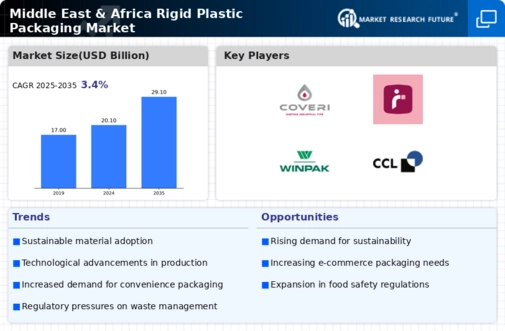Market Growth Projections
The Global Middle East & Africa Rigid Plastic Packaging Market Industry is projected to experience substantial growth in the coming years. The market is expected to reach 20.1 USD Billion in 2024 and is forecasted to grow to 29.1 USD Billion by 2035. This growth trajectory suggests a compound annual growth rate of 3.4% from 2025 to 2035. Such projections indicate a robust demand for rigid plastic packaging solutions across various sectors, including food and beverage, pharmaceuticals, and consumer goods. The anticipated growth reflects the increasing reliance on rigid plastic packaging as a versatile and effective solution for diverse packaging needs.
Increasing E-commerce Activities
The rise of e-commerce is significantly influencing the Global Middle East & Africa Rigid Plastic Packaging Market Industry. With more consumers opting for online shopping, the demand for robust and secure packaging solutions has surged. Rigid plastic packaging provides the necessary protection for products during transit, ensuring they arrive in optimal condition. This trend is particularly evident in sectors such as electronics and cosmetics, where product integrity is paramount. As e-commerce continues to expand, driven by changing consumer behaviors, the market is poised for growth, with projections indicating a substantial increase in demand for rigid plastic packaging solutions.
Growth in Food and Beverage Sector
The food and beverage sector is a critical driver for the Global Middle East & Africa Rigid Plastic Packaging Market Industry. The increasing population and urbanization in the region have led to a surge in demand for packaged food and beverages. Rigid plastic packaging offers advantages such as durability, lightweight, and convenience, making it a preferred choice for manufacturers. For example, the rise of ready-to-eat meals and on-the-go beverages has significantly boosted the need for effective packaging solutions. This growth is expected to contribute to the market's expansion, with projections indicating a market size of 29.1 USD Billion by 2035, reflecting the sector's pivotal role in driving demand.
Technological Advancements in Packaging
Technological advancements play a crucial role in shaping the Global Middle East & Africa Rigid Plastic Packaging Market Industry. Innovations in packaging technology, such as improved barrier properties and enhanced design capabilities, are enabling manufacturers to create more efficient and appealing packaging solutions. For instance, the introduction of smart packaging technologies, which can monitor product freshness and provide real-time information to consumers, is gaining traction. These advancements not only enhance product shelf life but also improve consumer engagement. As a result, the market is likely to experience a compound annual growth rate of 3.4% from 2025 to 2035, driven by the continuous evolution of packaging technologies.
Regulatory Support for Packaging Innovations
Regulatory frameworks are increasingly supporting innovations within the Global Middle East & Africa Rigid Plastic Packaging Market Industry. Governments are implementing policies that encourage the development and adoption of advanced packaging solutions, particularly those that promote sustainability and reduce environmental impact. For example, initiatives aimed at reducing single-use plastics are prompting manufacturers to explore alternative materials and designs. This regulatory support not only fosters innovation but also enhances market competitiveness. As companies adapt to these regulations, the market is expected to benefit from increased investment in research and development, further driving growth in the coming years.
Rising Demand for Sustainable Packaging Solutions
The Global Middle East & Africa Rigid Plastic Packaging Market Industry is witnessing a notable shift towards sustainable packaging solutions. As consumers become increasingly environmentally conscious, companies are compelled to adopt eco-friendly materials and practices. This trend is reflected in the rising demand for recyclable and biodegradable rigid plastic packaging options. For instance, major brands are investing in innovative technologies to enhance the sustainability of their packaging. This shift not only meets consumer expectations but also aligns with regulatory pressures aimed at reducing plastic waste. Consequently, the market is projected to reach 20.1 USD Billion in 2024, indicating a robust growth trajectory driven by sustainability initiatives.















Leave a Comment